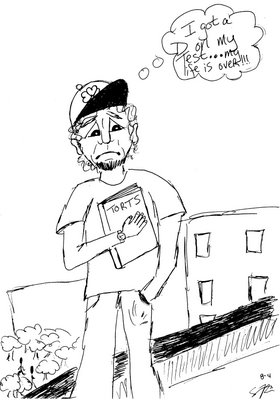Week Eight, Part 4 - Torts: How To Take A Fact-pattern Exam
 In Torts, Professor Charles Rice says that the mock mid-term will only have one section: a long fact-pattern. Unlike the final exam, there will be no objective questions or short essay.
In Torts, Professor Charles Rice says that the mock mid-term will only have one section: a long fact-pattern. Unlike the final exam, there will be no objective questions or short essay.“What do you do with a fact-pattern?” Rice asks. He answers it himself: “You find the issue, milk it, and move on! How? First you read straight through the fact-pattern. Second, you read the thing again and mark it up. Now you’re ready to write an answer.”
Rice runs his hand over the top of his crew cut, waiting for us to stop writing and look up. “The fact-pattern will have a lot of issues, and you get points for each one you spot. Tell me the issues and who wins. Anything that's in your fevered little brain, put on the paper! As long as you find the issue, decide it, and don't make an error of law, you can't be wrong.
“Don't give me a big lecture,” Rice adds. “Don’t tell me, ‘This is very interesting.’ Don't talk about conversion like it's trespass. Be careful with transferred intent.”
Rice glares at us like an angry drill sergeant. “We’ll find out if some of you are treating this subject like a tourist.”
I’m not sure exactly what that means, but assume it implies lack of diligence. Guilty as charged. After eight weeks, my torts notes are still a tangled mess. Instead of writing my own case briefs, I been copying them out of the study guide. I’ve yet to start memorizing even the elements of each intentional tort.
In short order, Rice reviews the basics of negligence: “DTY, BRCH, CSTN, DMGS.” Then he quizzes us on six cases dealing with negligence per se. This doctrine “refers to acts which implicitly involve a breach of duty, obviating the need to expressly allege the existence of a duty.”
I write down “automatic negligence” in my notes.
Rice says, “Statutes are a shorthand way to define duty. For example, if you speed, have you breached the duty of care. However, issue of causation is still determined by jury unless it's so obvious that a reasonable person could not disagree.”
We discuss whether a statute can have more than one purpose. Rice says, “Yes, unless it's written in stone on Mt. Sinai.”
After class, about fifteen or so “gunners” congregate at the front around Rice. They pepper him with questions about the mock mid-term. I follow them down, just to make sure I’m not missing the secret of law school success.
To my surprise, Rice is not helpful. He steers away from specifics and dismisses some questions with the wave of his hand.
He ends the Q&A by raising his voice slightly so we can all hear. “Remember, a D or an F doesn't mean you should head for the 13th floor of Hesburgh.”
It’s a joke, but on my way to lunch, I wonder whether the pressure of Notre Dame Law School has ever driven a student to suicide.
Like they say, “D is for die."
* * *

0 Comments:
Post a Comment
<< Home